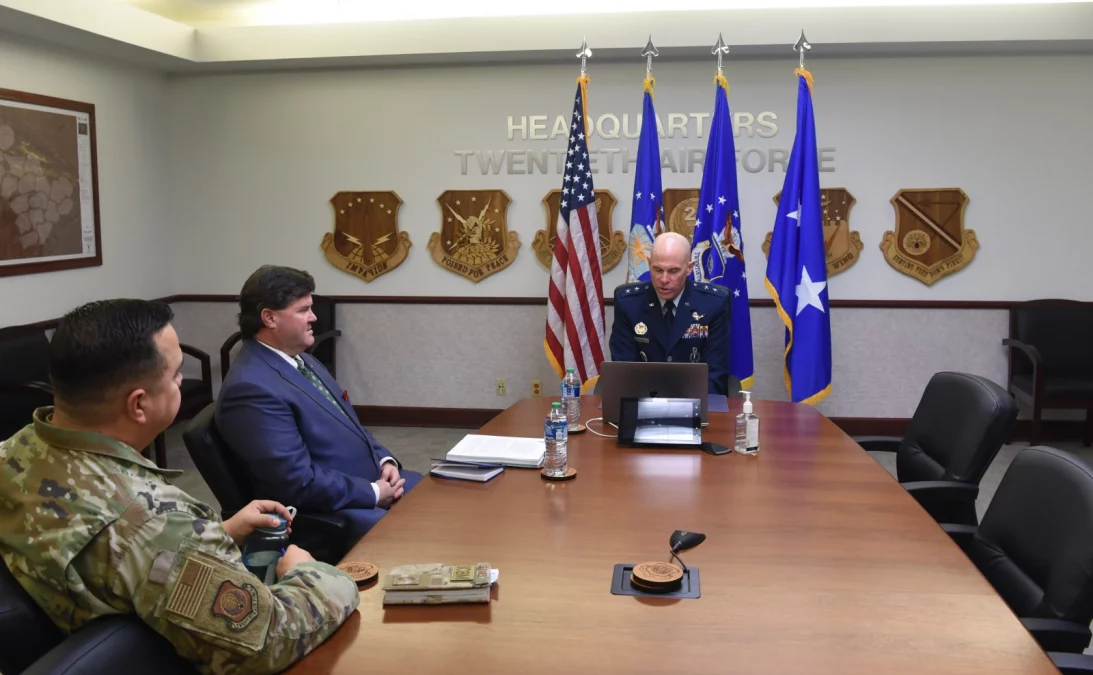The Minuteman III missile silos around Minot and at other Air Force installations are overdue for an upgrade; getting that project underway requires the cooperation and support of many partners and Native American nations. Developing a construction program that’s inclusive of all the partners has been a big undertaking, and the end of that work was marked with a document signing including many of the partners at Barksdale Air Force Base. The Air Force is (rightly) proud of the agreement and many partnerships they’ve fostered. Their news release is below.
Cover Image: Maj. Gen. Michael Lutton, 20th Air Force commander, right, gives remarks as the Air Force Global Strike Command representative during the Sentinel Programmatic Agreement Signing Ceremony with Ray Sumner, U.S. Air Force Cooperator for the Sentinel Project Center for Environmental Management of Military Lands, center, and Chief Master Sgt. Rodolfo Gamez Jr., 20th AF command chief, on his right Dec. 16, 2022 at F.E. Warren Air Force Base, Wyoming.
———BEGIN NEWS RELEASE, USAF ————-
BARKSDALE AIR FORCE BASE, La. —
More than 150 personnel who took part in drafting the LGM-35 Sentinel Programmatic Agreement participated in a historic signing event Dec 16, 2022, which simultaneously took place in 11 different locations.
The Air Force’s project to replace the aging LGM-30G Minuteman III with the LGM-35 Sentinel encompasses more than 34,000 acres of land, some of which is on property with both cultural and historical significance. The programmatic agreement, which has been in development for more than two years, will not only ensure the Air Force is in compliance with the National Historic Preservation Act, but has grown relationships with those who place great value on this land.
“The Air Force worked with all parties to develop an agreement that balanced the project’s national security priorities with the protection of the cultural resources within the project area. This approach recognized that the lands impacted by the project are the ancestral lands of indigenous peoples represented by over 63 tribal governments,” said Maj. Gen. Michael Lutton, Twentieth Air Force commander. “The agreement is designed to seek tribal input on the identification, documentation, evaluation and protection of sites and objects of tribal significance through all phases and areas of this project. Through a spirit of respect and cooperation, all parties worked to develop the strongest, most effective agreement possible.”
This agreement, which provides process and mitigation measures the Air Force will follow with regards to cultural resources, was signed by the Mandan, Hidatsa, and Arikara Nation in North Dakota; seven State Historic Preservation Officers; the Wyoming Attorney General’s office; the National Park Service Interior Region 6, 7 and 8; and the Advisory Council on Historic Preservation. The Little Shell Tribe of Montana and the Ward County Commissioners also signed the Agreement as concurring parties. The Air Force is continuing to work with the remaining 55 tribes, 10 Federal Agency regional offices, 11 state and local governments and agencies, and five non-governmental organizations that are consulting parties and have assisted in developing the document.
“I just want to acknowledge that we are tremendously pleased with the effort that the Air Force put into developing the consultation plan and carrying it out to engage in such an important number and array of stakeholders in that consultation, and to developing an agreement that very successfully incorporated historic preservation goals at every stage of the process and of the program,” said Reid Nelson, Advisory Council on Historic Preservation acting executive director. “We appreciate your commitment. This stands as a model for us of how an agency can carry out such a comprehensive and effective consultation on such an important program.”
This historic signing event would not have been possible without significant support from community partners and regional stakeholders.
“I wanted to thank the United States Air Force, all the other state federal and travel agencies and governments for their participation and our invitation to be part of this very prestigious event,” said Three Affiliated Tribes Chairman Mark Fox. “Nowhere in the world do they honor, revere or respect our servicemen, and those who have served, more so than we do. It’s a very important part of our culture. It goes back to our warrior’s societies, in a protection of our own people, but now as part of the United States military as well. We are very proud of that.”
Normally, programmatic agreements are simply staffed through each signatory and invited signatory and then forwarded to the Advisory Council on Historic Preservation for signature. However, due to the historical level of cooperation, all signatories met virtually to sign the document and further attest to their strong relationship and the importance of the agreement to national security.
“This is a historic agreement both in the scope of the project and the number of concerned parties,” said Maj. Gen. John P. Newberry, Air Force Nuclear Weapons Center Commander and Air Force Program Executive Officer for Strategic Systems. “The hard work and spirit of cooperativeness that allowed representatives from multiple tribes, state, federal and Air Force agencies to gather together on one day to fully execute this agreement is unprecedented and a true way forward to continue building on these relationships.”
The ability to build such a document is largely credited to the mindset of all involved.
“Through this process, we acknowledged the lands impacted by this project are the ancestral lands of indigenous peoples,” said Russell Bartholomew, AFNWC Sentinel Acquisition Program Manager. “It is important for all parties and individuals involved in this project to understand the long-standing history that has brought us to reside on the land and our place within that history. Tribal governments and Native American communities have a strong and overlapping interest in lands far removed from their reservations and current localities. In recognition of this reality, this agreement will facilitate all Tribal governments being able to provide input on the identification, documentation, evaluation, and protection of sites of Tribal significance throughout all phases and areas of the undertaking.”
The Sentinel system will replace the 400 Minuteman III intercontinental ballistic missiles, which have been in service for more than 50 years in Air Force missile fields near F.E. Warren Air Force Base, Wyoming; Malmstrom AFB, Montana; and Minot AFB, North Dakota. Some Sentinel maintenance, training, storage, testing and support actions will occur also at Hill AFB, Utah; Utah Test and Training Range, Utah; Camp Guernsey, Wyoming; and Camp Navajo, Arizona.
“A well-designed PA is meant to find the balance between the Air Force construction project and the protection of the cultural resources within the project area,” said Stephanie Newcomer, Air Force Civil Engineer Center Environmental Impact Statement project manager. “This Sentinel PA does that and has mitigated measures identified … to uphold that balance over the next 20-plus years.”



